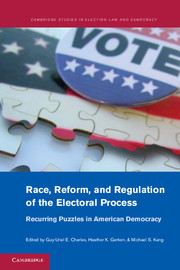Book contents
- Frontmatter
- Contents
- Figures
- Tables
- Contributors
- Preface
- Introduction: The Future of Elections Scholarship
- PART I RACE AND POLITICS
- PART II COURTS AND THE REGULATION OF THE ELECTORAL PROCESS
- PART III ELECTION PERFORMANCE AND REFORM
- Overview: Election Reform
- 8 New Directions in the Study of Voter Mobilization
- 9 Popular Election Monitoring
- 10 Democracy in the United States, 2020 and Beyond
- 11 Partisanship, Public Opinion, and Redistricting
- PART IV CONCLUSION
- Index
- References
8 - New Directions in the Study of Voter Mobilization
Combining Psychology and Field Experimentation
Published online by Cambridge University Press: 01 June 2011
- Frontmatter
- Contents
- Figures
- Tables
- Contributors
- Preface
- Introduction: The Future of Elections Scholarship
- PART I RACE AND POLITICS
- PART II COURTS AND THE REGULATION OF THE ELECTORAL PROCESS
- PART III ELECTION PERFORMANCE AND REFORM
- Overview: Election Reform
- 8 New Directions in the Study of Voter Mobilization
- 9 Popular Election Monitoring
- 10 Democracy in the United States, 2020 and Beyond
- 11 Partisanship, Public Opinion, and Redistricting
- PART IV CONCLUSION
- Index
- References
Summary
One of the most exciting developments in election studies is the increasing use of field experimentation to test insights from psychology and behavioral economics. Field experiments combine the rigorous estimation of causal effects that is the hallmark of experimentation with a more naturalistic setting than is characteristic of the typical social science experiment. Through the use of real-world settings rather than laboratories, field experiments attempt to reproduce the environment in which the phenomenon of interest naturally occurs. This realism is intended to minimize concerns about the external validity, or the generalizability of the experimental results.
There was not a single field experiment published in a major political science journal during the 1990s, but over the past decade, dozens of scholars have performed more than 100 experiments in which the effect of campaign activity is measured in real-world contexts. To date, the vast majority of this work examines political mobilization. In these experiments, subjects are randomly assigned to receive different communications. Early experiments suggested that the mode of contact (whether the potential voter was contacted face-to-face, by mail, or by phone) determined the effectiveness of the intervention, but the message delivered was of minimal importance (Gerber and Green 2000). This early finding was in tension with a large literature in social psychology showing that relatively modest differences in how alternatives are presented can have large effects on behavior. Recent work in political science lends support to the social psychology perspective: It appears that sometimes the message can make a substantial difference.
- Type
- Chapter
- Information
- Race, Reform, and Regulation of the Electoral ProcessRecurring Puzzles in American Democracy, pp. 179 - 191Publisher: Cambridge University PressPrint publication year: 2011



